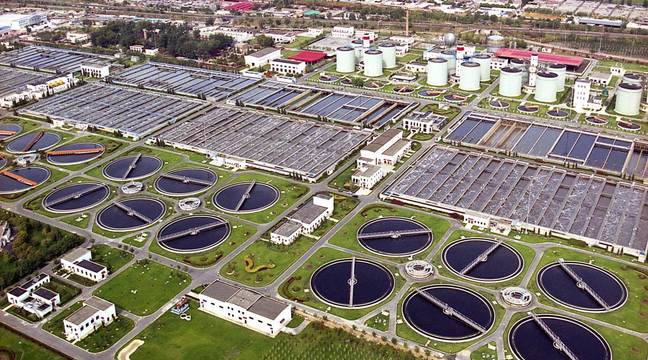
当前课程知识点:Water and Wastewater Treatment Engineering: Biochemical Technology > Chapter 2 Activated sludge process > Section 2.2 Growth rule of activated sludge and its application > Section 2.2 Growth rule of activated sludge and its application
返回《Water and Wastewater Treatment Engineering: Biochemical Technology》慕课在线视频课程列表
返回《Water and Wastewater Treatment Engineering: Biochemical Technology》慕课在线视频列表
同学们好!我们下面来学习活性污泥的增殖规律及其应用
活性污泥的增殖,是指其中的微生物的增长与繁殖
它必然会导致活性污泥的数量增加
这是活性污泥在曝气池中发生生化反应、降解废水中间的有机物的必然结果
通常,我们用活性污泥的增殖曲线来说明活性污泥的增殖规律
这张图是典型的活性污泥增殖曲线
横坐标是时间,纵坐标是微生物的量,同时也是废水中有机物的量
需要说明的是,这个图表达的是一次间歇培养活性污泥的试验结果
即在试验开始时,在某种废水中间集中一定量的微生物
然后持续地给废水中间曝气供氧
再观察其中活性污泥的增长的情况,以及废水中间有机物的降解情况
可以看出,随着时间的推移,微生物的量逐渐增加
而与此同时,废水中的有机物的量也则逐渐减少
当微生物的量增长到一定程度以后达到最高点
就会开始逐渐地减少
从上面的活性污泥的增殖曲线上
我们发现,微生物的增殖与有机物的量密切相关
因此在一个活性污泥系统中间
我们需要提出一个新的概念,即F/M值
是指在一个活性污泥系统中间
能够被微生物所利用的有机物的量跟相应的微生物的量之间的比值
也称为食微比,即食物,food,与微生物,microorganism,之间的比值
实际上,F/M值就是我们前面已经学习过的以BOD5表示的进水污泥负荷
我们可以看这个计算公式,就会发现F/M值就是指的进水污泥负荷
有研究表明,在温度适宜、溶氧充足、且不存在抑制物的条件下
活性污泥中间的微生物的增殖速率主要取决于F/M值
F/M值也是影响废水中间有机物去除速率和氧气的利用速率的重要的因素
根据活性污泥的增殖规律,我们可以将增殖曲线分为4个时期
第一是适应期,第二是对数增殖期
第三是减速增殖期,第四是内源呼吸期
我们首先来看适应期
它是指接种的微生物对于新的环境条件
废水中间不同种类的有机污染物等的一个短暂的适应过程
在这个过程中间,活性污泥中间的微生物基本上从数量上来看没有发生变化
但是菌体的体积略有增大
它其中的一些酶的系统也会做出相应的调整
或者有可能会发生一些新的变异
但是从表观上来看,废水的水质指标基本上没有发生变化
第二个时期称为对数增殖期
这个时候的特点是F/M值非常高
一般会超过2.2kgBOD5/kgVSS·d
在这种条件下,有机物非常丰富
营养物质不是微生物增殖的控制因素
微生物的增值速率跟基质浓度没有关系
他们之间呈零级反应
这个时候微生物增殖速率仅由微生物本身所特有的最小世代时间所控制
微生物会以最高的速率对有机物进行摄取
以最高速率进行增殖,合成新的细胞
活性污泥的代谢速率非常高,同时需氧量也非常大
这种条件下,活性污泥具有很高的能量水平
微生物的活动能力很强,污泥质地松散
不易形成较好的絮凝体,它的沉淀性能不太好
所以在正常的活性污泥运行中
我们一般不采用此阶段作为它的运行工况
但是也有一些特殊的情况,像高负荷活性污泥法
它会采用这种对数增殖期作为运行工况
第三个时期我们称为减速增殖期
随着前面的对数增殖期的进行,微生物的量不断增加
而食物的量或者说是废水中间有机物的量不断地下降
因此到这个时期,F/M值就下降到了一定的水平
有机物的浓度逐渐成为微生物增殖的控制因素
微生物的增殖速率跟残留的有机物的浓度呈正比
这时候它们之间呈一级反应关系
有机物的降解速率也开始下降
微生物的增殖速率逐渐下降,直至最终下降到零
但从表观上来看,活性污泥的量仍持续增长并且最终达到最高值
在这个阶段,活性污泥中间的絮凝体开始形成
活性污泥的凝聚、吸附以及沉淀性能都比较好
而且更重要的是出水水质有了很大的改善
整个系统的运行非常稳定
因此多数的污水处理厂它的曝气池都采用这个减速增殖期作为它的运行工况
最后一个阶段是内源呼吸期
内源呼吸的速率在这个时期第一次超过了合成速率
因此从整体上来说,活性污泥的量在逐渐减少
最终所有的活细胞都会消亡,而仅残留下内源呼吸的残留物
这些物质多半都是难于生物降解的细胞壁或者其他的一些细胞残留物
污泥的无机化程度在这个时期就比较高
因此它的沉降性能比较好
但是由于大部分的胞外多聚物的一些具有凝聚功能的有机物被降解
所以污泥的凝聚性较差
废水中间的有机物基本消耗殆尽,因此它的出水水质非常好
当然由于污泥的沉降性能不太好
所以多数的活性污泥厂也不会采用这个阶段作为运行工况
但是在一些特殊的情况下,也有采用的,像延时曝气法
因此,我们来看一下活性污泥增殖规律
总体来看,有这样4点值得大家总结一下
第一个我们发现,活性污泥的增殖状况主要是受F/M值控制
第二个是不同增殖期的活性污泥,它具有不同的性能,而且出水水质也不同
第三,通过调整F/M值,就可以调控曝气池的运行工况
从而达到所需要的出水水质以及活性污泥的良好性能
第四点,对于我们后期所要介绍的两种最主要的活性污泥的运行工况
一个称为"推流式活性污泥法",一个称为"完全混合式活性污泥法"
它们在微生物的增殖曲线上的表现,或者说它的位置是不一样的
对于推流式活性污泥法来说,它是一个线段
对于完全混合式活性污泥法来说,它是一个点
我们从这个图上可以看出,对于推流式曝气池来说
它的前端可能会从对数增殖期的后期,或者是减速增殖期的前期开始
那么它的末端,会在内源呼吸期的前期结束
而对于完全混合式活性污泥法来说
它可以是这条微生物增殖曲线上的不同位置上的一个点
它可以处在内源呼吸期的后期,这个相当于延时曝气
它也可以处在对数增殖期的后期,这相当于高负荷的活性污泥法
当然它也可以把它设定在减速增殖期的后期,或者是内源呼吸期的前期
这是通常,我们的运行工况
前面我们介绍了活性污泥的增殖曲线
通过对增殖曲线的了解,我们发现在活性污泥系统中间
除了关心出水水质以外,其实我们还要关心两个问题
一个是关于剩余污泥的产量,一个是关于需氧量
剩余污泥的产量实际上是跟微生物的增殖量直接相关
它跟有机物的降解也是密切相关的
活性污泥微生物增殖是微生物增殖和自身氧化或者说内源呼吸
两项作用的综合结果
所以,微生物的净增殖速率可以用这个公式来表示
其中,(dx/dt)g表示活性污泥微生物的净增值速率它的单位是kgVSS/d
而(dx/dt)s表示的是活性污泥中间微生物通过合成作用所形成的微生物的增量
其中的a是指活性污泥的产率系数,或者说是合成系数
指的是降解1kgBOD5所产生的VSS的量,它的单位可以用kgVSS/kgBOD5来表示
(dx/dt)e表示的是活性污泥通过内源呼吸作用所降解掉的
或者说是所减少的活性污泥的量
它可以用这个公式来表示
其中的b表示活性污泥的自身氧化系数
它的单位是kgVSS/kgVSS·d,有时简写为d^-1
但是实际上是指活性污泥在一天内通过自身氧化作用
或者说是内源呼吸作用所减少的活性污泥的量
当然这里面的Xv表示的是整个活性污泥系统中间活性污泥的总量
即我们前面说的V·X
前面我们是用微分关系来表示的这个微生物的增殖量跟有机物降解之间的关系
但是对于一个稳定运行的活性污泥系统来说
我们可以用这个公式来表达活性污泥系统中间微生物的增殖的量
即△x=aQSr-bVXv
这个公式中间△x表示的是整个活性污泥系统中间每天的污泥的增长量
它的单位是kgVSS/d
关于这个公式中间的a和b,我们通常可以通过经验值来获得
对于通常的生活污水来说,或者说是性质跟它相近的一些工业废水
a一般是在0.5-0.65之间,b是在0.05-0.1之间
但是对于一些特殊的工业废水
我们需要通过实验或者是通过其他的文献调研来获得
这里面给出了一些不同类的工业废水的a和b值
当然我们对于一种特殊的工业废水或者一种新的工业废水
我们可以通过设计实验来直接求得a值和b值
我们可以将前面这个公式改写成这个公式
我们可以发现在这样的一个公式之间污泥的增量跟系统的污泥负荷呈直线关系
我们如果在实验室能够设计这样的一个模型试验
用它来处理实际的工业废水,调整不同的污泥负荷
我们求得不同的微生物的增量,做出这条直线关系
就可以通过它的斜率和截距求得a值和b值
第二个所关心的问题是这样的一个活性污泥系统在处理废水的过程中间
需要把废水中的有机物降解,到底需要多少氧
因为对于活性污泥系统来说,或者说是对于其他的好氧生物处理工艺来说
氧是至关重要的
氧气在微生物的代谢过程中间,主要有两个方面的用途
第一,氧会被直接用来氧化分解废水中间的有机物
第二,一部分氧还需要用来氧化分解微生物自身的细胞物质
即通过内源呼吸会消耗一部分的氧
因此的话,我们可以用这样的一个公式来计算活性污泥工艺的需氧量
即O2=a'QSr+b'VXv
这个公式中间,氧代表的是活性污泥系统中间微生物的总的需氧量
单位是kgO2/d
而a'代表的是代谢每kgBOD5所需要的需氧量,这是一个氧化系数
b'指的是每kgVSS在每天进行内源呼吸所需要的需氧量
它的单位可以是kgO2/kgVSS.d
同样,我们也需要得到a'和b'的值
对于一些活性污泥工艺处理城市污水的时候,它的运行方式不一样
它的a'和b'值的范围也会不一样
我们这简单地给出了完全混合式活性污泥法的a'值和b'值
以及延时曝气法的a'值和b'值
可以看出,它们有比较大的差别
同时对于一些特殊的工业废水,它的a'值和b'值也会有比较大的差别
我们这里也是给出一些供大家参考的数值
但是对于一种新的工业废水来说
那我们就需要在实验室通过实验法来进行求取a'值和b'值
我们同样可以把前面的这个公式改写成这样的一个公式的形式
我们从这个公式上就能看到
对于活性污泥系统中间的kgVSS来说
它的需氧量跟它的污泥负荷成直线关系
同样,在实验室我们可以设立这样一个活性污泥的系统
用它来处理这种实际的废水,调整它不同的污泥负荷
求得kgVSS每天实际的需氧量,做出这条直线关系
通过这个直线关系,我们就可以求得a'和b'值
好,这节课就到这,谢谢!
-Section 0.1 Development Status of Wastewater Treatment Process
--Section 0.1 Development Status of Wastewater Treatment Process
-Section 0.2 Typical Processes of Wastewater Biological Treatment
--Section 0.2 Typical Processes of Wastewater Biological Treatment
-Section 1.1 Principles of wastewater aerobic biological treatment
--1.1 Principles of wastewater aerobic biological treatment
-Section 1.2 Principles and determination of wastewater biodegradability
--1.2 Principles and determination of wastewater biodegradability
-Section 1.3 Principles of wastewater anaerobic biological treatment
--Section 1.3.1 Principles of wastewater anaerobic biological treatment(1)
--Section 1.3.2 Principles of wastewater anaerobic biological treatment(2)
-Section 1.4 Principles of wastewater biological nitrogen removal
--Section 1.4 Principles of wastewater biological nitrogen removal
-Section 1.5 Principles of wastewater biological phosphorus removal
--Section 1.5 Principles of wastewater biological phosphorus removal
-Chapter 1 Homework
-Section 2.1 Basic concept of activated sludge process
--Section 2.1.1 Basic concept of activated sludge process
--Section 2.1.2 Basic concept of activated sludge process
-Section 2.2 Growth rule of activated sludge and its application
--Section 2.2 Growth rule of activated sludge and its application
-Section 2.3 Running mode of activated sludge process
--Section 2.3.1 Running mode of activated sludge process(1)
--Section 2.3.2 Running mode of activated sludge process(2)
-Section 2.4 Kinetics of active sludge process
--Section 2.4.1 Kinetics of active sludge process(1)
--Section 2.4.2 Kinetics of active sludge process(2)
--Section 2.4.3 Kinetics of active sludge process(3)
--Research and Development of Kinetic Model of Activated Sludge Process
-Section 2.5 Principle, calculation and equipment of aeration
--Section 2.5.1 Principle, calculation and equipment of aeration(1)
--Section 2.5.2 Principle, calculation and equipment of aeration(2)
-Section 2.6 Designing of activated sludge process
--Section 2.6 Designing of activated sludge process
-Section 2.7 Operation and management of active sludge process
--Section 2.7.1 Operation and management of active sludge process (1)
--Section 2.7.2 Operation and management of active sludge process (2)
-Chapter 2 Homework
-Section 3.1 Basic principle of biofilm
--Section 3.1 Basic principle of biofilm
-Section 3.2 Biofilter process
--Section 3.2.1 Biofilter Process (1)
--Section 3.2.2 Biofilter process (2)
--Section 3.2.3 Biofilter process (3)
-Section 3.3 Biodisk process
-Section 3.4 Biological contact oxidation process
--Section 3.4 Biological contact oxidation process
-Section 3.5 Aerobic biological fluidized bed process
--Section 3.5 Aerobic biological fluidized bed process
-Chapter 3 Homework
-Section 4.1 Oxidation ditch process
--Section 4.1 Oxidation ditch process
-Section 4.2 A-B process
-Section 4.3 SBR process
-Section 4.4 MBR process
-Chapter 4 Homework
-Section 5.1 Overview and characteristics of development of anaerobic biological treatment
--Section 5.1 Overview and characteristics of development of anaerobic biological treatment
-Section 5.2 Anaerobic digester
--Section 5.2 Anaerobic digester
-Section 5.3 Anaerobic contact process and anaerobic filter process
--Section 5.3 Anaerobic contact process and anaerobic filter process
-Section 5.4 UASB process
-Section 5.5 Other anaerobic biological treatment process
--Section 5.5 Other anaerobic biological treatment process
-Section 5.6 Operation management of anaerobic biological treatment process
--Section 5.6 Operation management of anaerobic biological treatment process
-Chapter 5 Homework
-Section 6.1 Introduction
-Section 6.2 Biological nitrogen removal process and technology
--Section 6.2 Biological nitrogen removal process and technology
-Section 6.3 Biological phosphorus removal process and technology
--Section 6.3 Biological phosphorus removal process and technology
-Section 6.4 Simultaneous nitrogen and phosphorus removal process
--Section 6.4 Simultaneous nitrogen and phosphorus removal process
-Chapter 6 Homework
-Section 7 Natural biological treatment process
--Section 7 Natural biological treatment process
-Chapter 7 Homework
-Section 8.1 Source, nature and treatment of sludge
--Section 8.1 Source, nature and treatment of sludge
-Section 8.2 Sludge thickening and digestive stability
--Section 8.2 Sludge thickening and digestive stability
-Section 8.3 Sludge conditioning, dehydration and incineration
--Section 8.3 Sludge conditioning, dehydration and incineration
-Chapter 8 Homework
-Section 9 Wastewater Discharge and Reuse
--Section 9 Wastewater Discharge and Reuse
-Chapter 9 Homework
